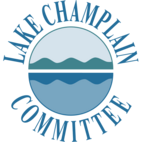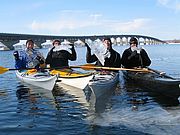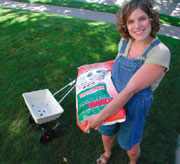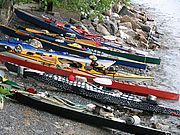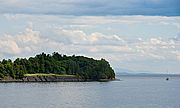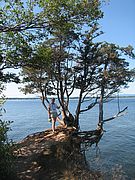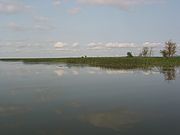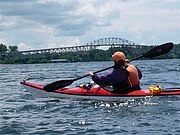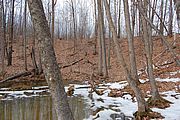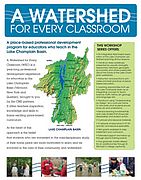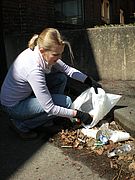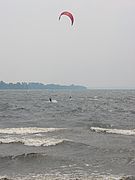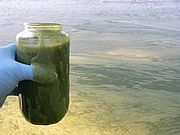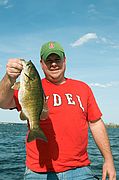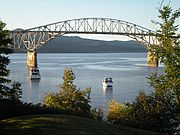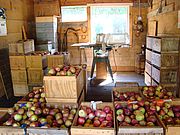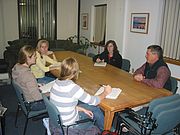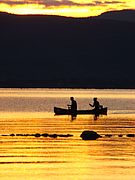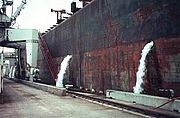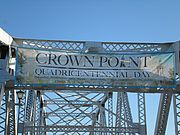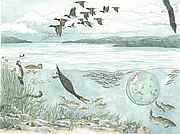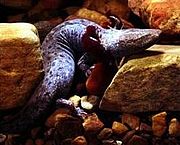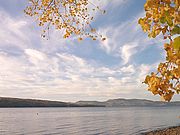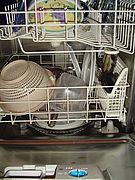Even if air temperatures seem balmy, the lake takes much longer to warm up. Additionally, strong currents and the presence of springtime debris add to risks this time of year. Current Lake Champlain temperatures are in the low 40s. If you are immersed in water that cold for less ... Read...
News from Selected Category
We can create a cleaner lake – with your help! Some of the pollutants that trigger algae blooms, close beaches and cause other problems in the lake come from our own homes and driveways. Taking simple actions such as picking up after your pet, using non-phosphorus dishwasher detergent, and repositioning gutters to drain onto grass, soil ... Read...
Follow these easy tips for a beautiful green lawn, not a green lake! For more information on how to care for your lawn and the lake - including retailers that carry phosphorus-free fertilizer -- check out the Lawn to Lake website www.lawntolake.org. ... Read...
Eastern Mountain Sports is hosting a special club day event to give back to the community. On April 23rd and 24th members of outdoor clubs and organizations like the Lake Champlain Committee will receive 25% off all EMS brand gear and 20% off everything else in the store! Bring this email as proof of membership (if you’ve renewed your LCC support this year). If you get restless while shopping you can check out the climbing wall set up in the parking lot. Read...
Paddlers on quiet back waters may notice multitudes of snails floating upside down near the surface. However, close inspection will reveal that the snails aren’t floating, they’re crawling. The snails actually have the ability to attach themselves to the underside of the surface film and propel themselves forward; all the while feeding on the detritus and algae along the surface just as they would along the glass in a fish tank... Read...
The week of November 17, 1963 newspaper headlines were occupied with the recent return of a Yale professor after more than two weeks in a Soviet prison where he had been accused of spying...
Stephen & Burns Salon Spa and Boutique in Burlington is celebrating the lake by hosting a Service-a-thon from 11:00 AM until 4:00 PM on April 18th to benefit LCC’s work. For $35 you can give yourself -- and the lake -- a lift with a stylish haircut, cleansing facial, or rejuvenating massage. Advance reservations at 802 865-4766 are recommended to ensure you get an appointment. Click here for a map to the salon at 116 Church Street. Read...
Feeling a bit shaggy? Are your locks too long? Is your coif in need of shaping? Get your hair cut or trimmed on Sunday April 11th and help LCC and the Lake! Head to O'Brien's AVEDA Institute at 1475 Shelburne Rd in South Burlington between noon and 4:00 PM for a cut-a-thon to benefit the Lake Champlain Committee. Look good and feel even better by helping to safeguard Lake Champlain. When it comes to our water source we are all "localvores." A minimum donation of $10.00 per haircut is requested with all funds going to LCC! Click here for directions to the cut-a-thon location. Read...
Don some green this coming Sunday and join in the rally to save Point Au Roche State Park. Ride your bike, walk, put your kayaks on top of your car, take your birding binoculars and bring a sign in support of the Park. The Plattsburgh site is among the 41 parks and historic sites slated for closure by the New York State Office of Parks and Recreation (NYOPR). The closures are part of NYOPR’s $29 million budget cut and are set to start April 1. The Park is a tremendous community resource that includes a public beach, 60 moorings, picnic facilities, and twelve miles of hiking trails that wind through a variety of interesting habitats including woods, rocky bluffs, wetlands, and shoreline. Point Au Roche State Park is also part of the Lake Champlain Paddlers’ Trail and provides primitive camping exclusive to paddlers in a small secluded and protected bay.
Rally participants will gather near Assemblywoman Janet Duprey’s office at 202 US Oval to deliver petitions and resolutions and present a show of force in support of the Park. For more information, contact Mary Simmers, President of the Friends of Point Au Roche State Park at simmersml@aol.com. The Oval is off Route 9 on the south side of Plattsburgh. Take the east outlet at the traffic circle on Route 9 (two planes from the old Air Force Base will be visible) and it will take you into the south end of the Oval. Read...
Lake Champlain Committee staff scientist Mike Winslow will be the featured speaker at the annual meeting of the Missisquoi River Basin Association on Thursday March 25th at 7PM at the Richford Town Hall. Learn about the forces that shape Lake Champlain, the creatures that call it home, and the special role of rivers like Missisquoi in defining Lake Champlain’s ecology. Copies of Lake Champlain: A Natural History will be available for purchase and author Mike Winslow on hand to pen special inscriptions. Free event. Read...
On March 26th -27th Canoe Imports, of South Burlington, one of the early business supporters of the Lake Champlain Paddlers’ Trail will host a two day celebration of paddling in Vermont. The program includes a showing of whitewater, canoe and sea kayak movies, a river festival, and a white water race. In addition, members of the Lake Champlain Committee and other selected non-profits will receive a discount on items purchased at the Canoe Imports store on Friday from 10 AM – 6 PM. On Saturday, if you become a member of LCC, you will receive a 10% discount on boats and 20% discount on accessories from 10 AM – 2 PM. Come stop by our booth on Saturday and say hi! To find out more information, visit the Canoe Imports website. Read...
Scientists at the Vermont Center for Ecostudies are attempting to identify and protect vernal pools in the state. Vernal pools provide critical breeding habitat ... Read...
Watershed for Every Classroom" is a year-long professional development experience for educators in the Lake Champlain Basin (Vermont, New York and Quebec), brought to you by the Champlain Basin Education Initiative of which LCC is a member. It offers teachers inspiration, knowledge and skills to frame exciting place-based curriculum and teach lake science and stewardship. At the heart of this approach is the belief that students who are immersed in interdisciplinary study of their home community are more likely to engage in stewardship. Educator workshops will be held in July and October 2010 and February and May 2011.
The course fee is $400, payable during the course. Participating teachers will receive $100 for classroom resources and an opportunity to apply for a $200 mini-grant. Five optional graduate credits are available for an additional $1,000 from St. Michael's College. Check out the brochure flier for further details. Read...
As ice and snow melt they reveal a winter’s worth of detritus along our roadsides and walkways: dog droppings, sodden papers, and blown rubbish. Instead of just side stepping the mess, take a moment to clean-up some of the wayward waste before it gets washed away into our rivers and lakes with upcoming April showers. Bring a bag and some gloves along on your spring walks.Read...
There is an old saying: to be wise means to have good judgment; good judgment comes from experience; and experience comes from having bad judgment. Rapid changes in conditions that can occur on a large lake like Champlain enhance the many opportunities for bad judgment to generate stories and adventures.
“If you don’t watch out, the lake can turn and bite you”, relates Irving Mehady, an avid outdoorsman I met recently. He tells a tale of duck hunting at Rock Dunder near Shelburne Bay. He and a companion had taken out their flat-bottomed skiff and hunkered down on the east side of the Rock to await the birds. After an unproductive morning Irving decided to climb up over the rock to see if the ducks might be on the other side. His eyes bulged as he saw the line of black clouds working its way swiftly over the lake pushing heaving white capped waves in front. He hurried back to his companion and they quickly set off for the mainland. Skiffs aren’t designed to handle rough weather.The storm caught up with them and rocked the boat too and fro. It was only with great fortune that they managed to reach shore. Read...
Lake Champlain has been designated a national ‘Great Water’ through the America’s Great Waters Coalition. The Coalition was launched in December 2009 by the National Wildlife Federation and an Alliance of more than 30 national, regional, state and local organizations to protect, preserve and restore America’s Great Waters. Lake Champlain now joins Chesapeake Bay, the Everglades, the Great Lakes, the Gulf of Maine, Long Island Sound, the Mississippi River, and San Francisco Bay as a ‘Great Water’. To earn the designation, waterways had to be of a certain size and scale, have a comprehensive restoration plan in place or in development, and have organized stakeholder involvement.
“It’s clear that Lake Champlain meets the requirements and deserves to be included,” said Lori Fisher, LCC Executive Director who wrote the application to get Lake Champlain considered. “It is a nationally significant waterbody, with extensive community involvement in the restoration and protection efforts underway. We look forward to working with Coalition members across the country to increase funding and support for Lake Champlain and other precious waterways that sustain people, wildlife and the economy.”
Senator Leahy said, "It isn't news to Vermonters that Lake Champlain is 'great.' And this is more great news if it helps us to secure more resources and attention for the conservation and restoration of Lake Champlain.”
The Lake Champlain Committee will be working to do just that as a member of the Great Waters Coalition. “The goal of this effort is to make the restoration and conservation of our waterways a national priority,” said Fisher. Read...
My first car was a gray AMC Concord. Gray aptly described my mood when it made one of its frequent trips to the mechanic. On one of those occasions I was complaining to my father about how long it took to do the work. “Son,” he said, “you can have the work done well, done cheap, or done fast. Pick two.” No work is perfect; trade-offs need to be accepted.
Trade-offs exist with regard to water pollution too. The severity of different problems varies within Lake Champlain from lake segment to lake segment. Anglers are warned that eating too much fish can be bad for their health because of high mercury levels in the fish, and the mercury levels are likely to be highest in fish from the cold clear waters of the Main Lake. Algae blooms plague northern bays occasionally leading to beach closures. Invasive weeds infest the southern lake making boating and swimming difficult. Each part of the lake has issues that raise concern. However what people in one part of the lake perceive as a problem can actually minimize the other potential problems.
New York and Vermont officials are looking for input today on the design for the new Lake Champlain Bridge. Six designs for a replacement bridge have been proposed and you can vote for your favorite through midnight tonight. The 80-year-old Lake Champlain Bridge, which spans the state line between Crown Point, New York and Chimney Point, Vermont, was closed in October after inspections revealed it was structurally unsafe. State officials have determined that rehabilitating the bridge is not feasible given the extensive deterioration, moving the bridge location would entail too lengthy an environmental review process, and replacing it with a permanent ferry would not meet the needs of the community.
LCC is participating in the bridge review process. We are advocating for a thorough, thoughtful plan for both bridge demolition and construction that minimizes and mitigates environmental impacts, includes bike and pedestrian corridors on the new bridge, and ensures the design fits with the surrounding lake and landscape.
Six designs were unveiled at meetings held in Ticonderoga on Saturday. You can check them out on-line, complete a survey providing feedback on the alternatives and submit ideas on how to commemorate the historic bridge, which was shut down in October. The survey will only be available until midnight Monday December 14. We like the “Network Tied Arch Bridge” designs as the basket handle arch best emulates the pleasing lines of the old bridge, it complements and fits within the setting, and is less expensive and easier to maintain than some of the other proposals.
The old bridge will be demolished using explosives in the next several weeks. A new bridge is anticipated to be open by the summer of 2011 at a cost of roughly $65 million. Read...
Numerous bass fishing tournaments are held around the lake each year. A fish kill from a recent Plattsburgh event rekindled concerns about the number of fishing tournaments on the lake and raised questions about the impact to the bass fishery. To help guide discussions on this issue, the Lake Champlain Fisheries Leadership Institute Seminar Series is hosting a presentation by Dr. Bruce Tufts of Queen’s University in Ontario. Dr. Tufts is a recognized expert on Bass biology and catch and release fishing. The program is free and open to the public and will be held at the Cardinal Lounge at PSUNY’s Angell College Center. The program is sponsored by Lake Champlain Sea Grant, Great Lakes Research Consortium, and the Lake Champlain Research Institute. For more information contact timothy.mihuc@plattsburgh.edu at SUNY Plattsburgh’s Lake Champlain Research Institute or mark.malchoff@plattsburgh.edu at Sea Grant. Read...
New York Governor David A. Paterson and Vermont Governor Jim Douglas have received a report from their states' respective transportation agencies which finds that it is not feasible to rehabilitate the Champlain Bridge. Engineers have declared that the 80-year-old span is too unstable to be renovated, and recommend demolishing the bridge for the safety of motorists and boaters. The Federal Highway Administration is expected to concur with the recommendation based on their preliminary review of the report. Transportation officials anticipate building a new bridge as close as possible to the current location. Read...
As you go about your food preparations for Thanksgiving and other upcoming holidays, consider supporting local farmers. If you live in the Champlain Valley, finding eggs, butter, cheese, cream and milk and even poultry produced nearby is fairly easy regardless of the season. However, local beets, potatoes, onions, garlic, carrots, pumpkins, squash, apples and other staples are often available even into November and December. Providing a meal where most of the food comes from within a 30-mile radius of home can deepen the meaning of Thanksgiving.
According to the Vermont Department of Agriculture, shifting just 10% of food purchases to locally grown food products, would add more than $100 million to the state’s economy. Any day of the year buying local foods offers thanks for the bounty we share living in the Champlain Valley. Read...
Why do clouds hang low over the lake on autumn mornings?
Where do invasive species come from and how do they arrive?
How might global warming affect Lake Champlain’s future?
How did the lake get here?
Hundreds of University of Vermont students are learning the answers to these and many more questions through LCC’s award-winning book Lake Champlain: A Natural History. The book is required reading this semester in Dr. Larry Forcier’s Natural History and Field Ecology class where students learn about the dynamics of the natural world.
You can join in the lake learning too by purchasing a copy of the book through LCC’s secure online Lake Shop. The 160-page illustrated publication covers the lake’s geology, geography, biology, and ecology in an accessible, engaging style. It makes a great gift for friends, family, fellow lake lovers or yourself! Read...
Sometime in November or December those who spend time on the lake in quiet contemplation might notice the normally clear water becomes murky, despite the absence of rain. A stale rotten smell may fill the air, even though the summer's algae blooms are long since passed. Lake Champlain will be in the midst of one of its twice yearly mixings. The mixing, also called turnover, occurs because, the water column in a given section of the Lake is of uniform temperature for the first time since spring.
During the summer months the Lake is layered, less dense and warm above, more dense and cool below with a sharp transition, a thermocline, somewhere in the middle. So long as the upper warm layer absorbs heat the temperature and density differences between the layers is accentuated. In addition to temperature differences, the cool bottom layer has less oxygen. Fish and other creatures take oxygen from the water and, because this layer is trapped below the warm layer above and not in contact with the air, the supply is never replenished.
Each year thousands of ships move between the Great Lakes and the Atlantic Ocean. Some carry more than cargo and crew; they hide animals or plants from distant lands. A new invasive species is found in the Great Lakes every 28 weeks on average. While throughout history species have expanded their ranges, only in modern times has such movement between continents, assisted by humans, been so easy and so frequent.
Species that arrive in the Great Lakes don’t necessarily stay there. They travel, often eastward toward Lake Champlain. Intercontinental traffic brought zebra mussels to the Great Lakes, the original introduction point for all North American populations. Zebra mussels made their way through canals or attached to other boats, reaching Lake Champlain by the early 1990s, ten to fifteen years after first being seen in the Great Lakes.
In late September, LCC celebrated its 46th annual meeting as part of the Crown Point Quadricentennial and Festival of Nations. The Crown Point Bridge was an integral part of the bi-state events. Thousands of participants crisscrossed the lake in cars and on foot to take in music, theater, films, and natural and cultural history programs at Chimney Point and Crown Point State Historic sites. Less than a month later, the bridge was abruptly closed indefinitely when inspectors discovered that at least two of the 80-year old concrete piers were in danger of collapse.
The effect was immediate and severe in an area where people live on one side of the water and work on the other, farms straddle state lines, and businesses have been built around cross lake traffic. Commutes have more than doubled in time and money, employees have been laid off, and some people have resorted to boating across the lake in the dark to get to and from work.
The bridge symbolizes the connectedness of Champlain Valley residents. Its closure has brought to light one fact that sometimes gets ignored – our shared reliance as a lake community. What happens on one side of the water affects the other. Recognition of our interconnectedness will not only help us address the transportation challenges at hand but should also inform all our environmental policy decisions from reducing nutrient loading to combating invasive species. Read...
Check out LCC’s Lake Shop for the perfect present for a fellow lake lover. We have lake note cards, art prints, and a great natural history book to help you celebrate friendships, thank a host, stuff stockings, and remember the holidays. You can also give a gift membership. Recipients of a $40 membership will be notified of your gift in December and sent the 2010 Lake Champlain Paddlers’ Trail Guidebook in June. Recipients of a $55 membership will receive an autographed copy of LCC’s award winning natural history book in December and the 2010 trail guidebook in June. Just fill out the online new membership form, check the “gift membership” box, and we’ll do the rest! Read...
The largest known population of mudpuppies on Lake Champlain was found recently in the Lamoille River when over 500 of the reclusive nocturnal amphibians were killed by chemicals added to the river to kill sea lamprey. It is unknown how many mudpuppies survived. Mudpuppies, particularly juveniles, are known to be susceptible to the lampricides and have been affected by many treatments around the lake. Fewer than 200 mudpuppies were killed in the largest prior die-off on the Ausable River.
Mudpuppies are large salamanders that never lose their external gills. They spend their entire lives in the water and populations are extremely difficult to survey. They feed principally on small invertebrates. They are long-lived and do not reproduce until they are about six years old. The first mudpuppy ever described by science came from Lake Champlain. In 2002 the state of Vermont’s Reptile and Amphibian Species Advisory Group recommended that mudpuppies be listed as threatened in Vermont, but the Agency of Natural Resources did not accept that recommendation.
LCC Staff Scientist Mike Winslow will discuss the historic and on-going cooperative efforts to protect Lake Champlain. Learn more about the lake, what is being done to restore its health, and how you can make a difference in Lake Champlain’s future, during this free evening program. Click here for directions to Hawkins Hall. Co-sponsored by the Lake Champlain Committee and the Lake Champlain Research Institute.
Can’t attend but want to learn more about Lake Champlain?
Purchase a copy of LCC’s award-winning natural history book through our Lake Shop.The 160-page publication covers the lake’s geology, geography, biology, and ecology in an accessible, engaging style. It makes a great gift for friends, family, fellow lake lovers or yourself! Read...
Keep the lake in mind when loading your automatic dishwasher and use phosphorus-free detergent. Check the labels on the products you buy to ensure the brand you choose doesn’t include phosphorus to avoid sending excess nutrients into our waterways.
Research and lobbying by LCC led to passage of legislation in Vermont to ban phosphates from household dishwasher detergents in 2010. Similar legislation in NY was introduced earlier this year (S.3780 and A.8914) but has not yet passed. According to independent studies by Consumer Reports, phosphate-free automatic dishwasher detergents work as well as those with phosphates.
For more lake friendly tips, check out the Learn and Get Involved sections of our website and consider taking our Lake Protection Pledge. Read...
